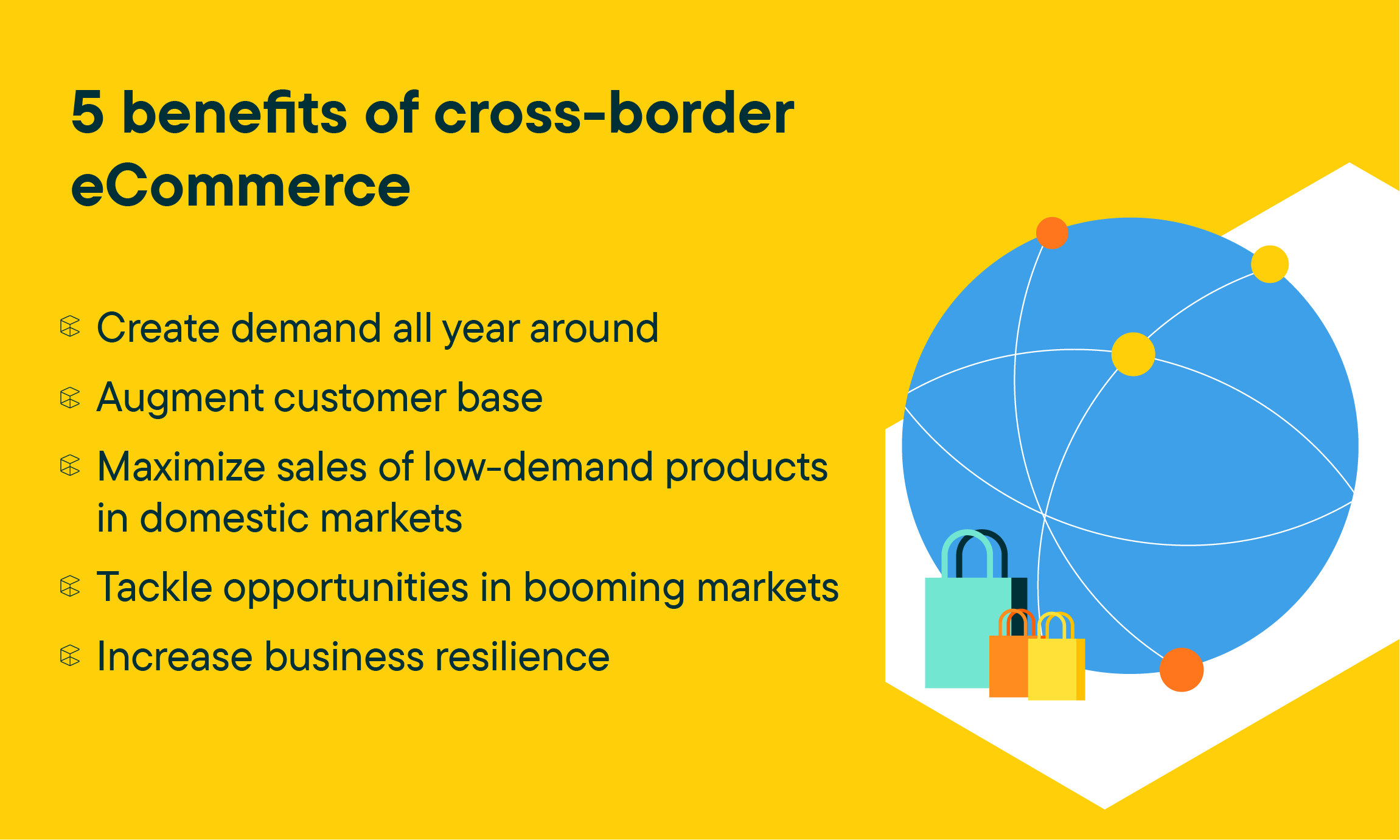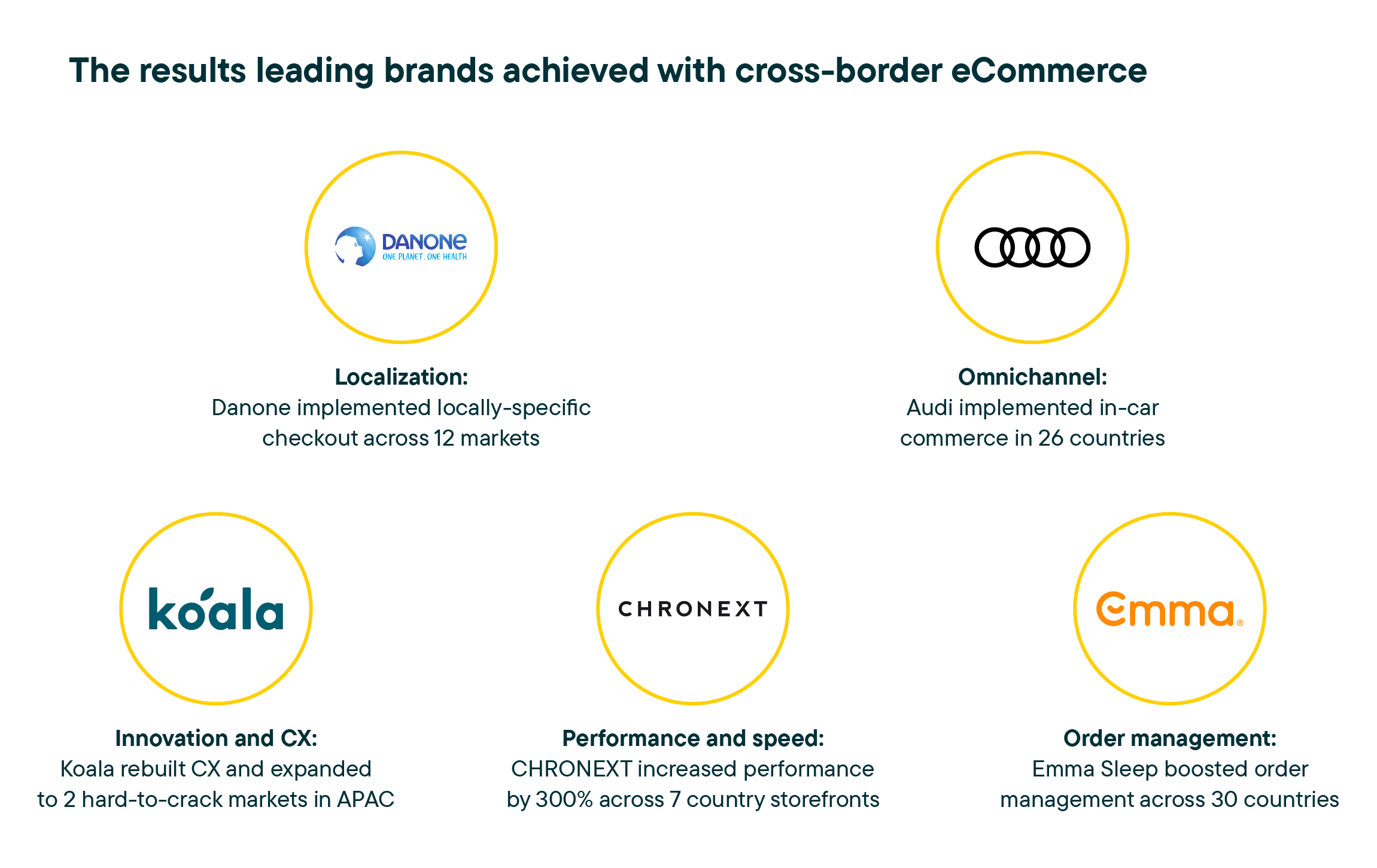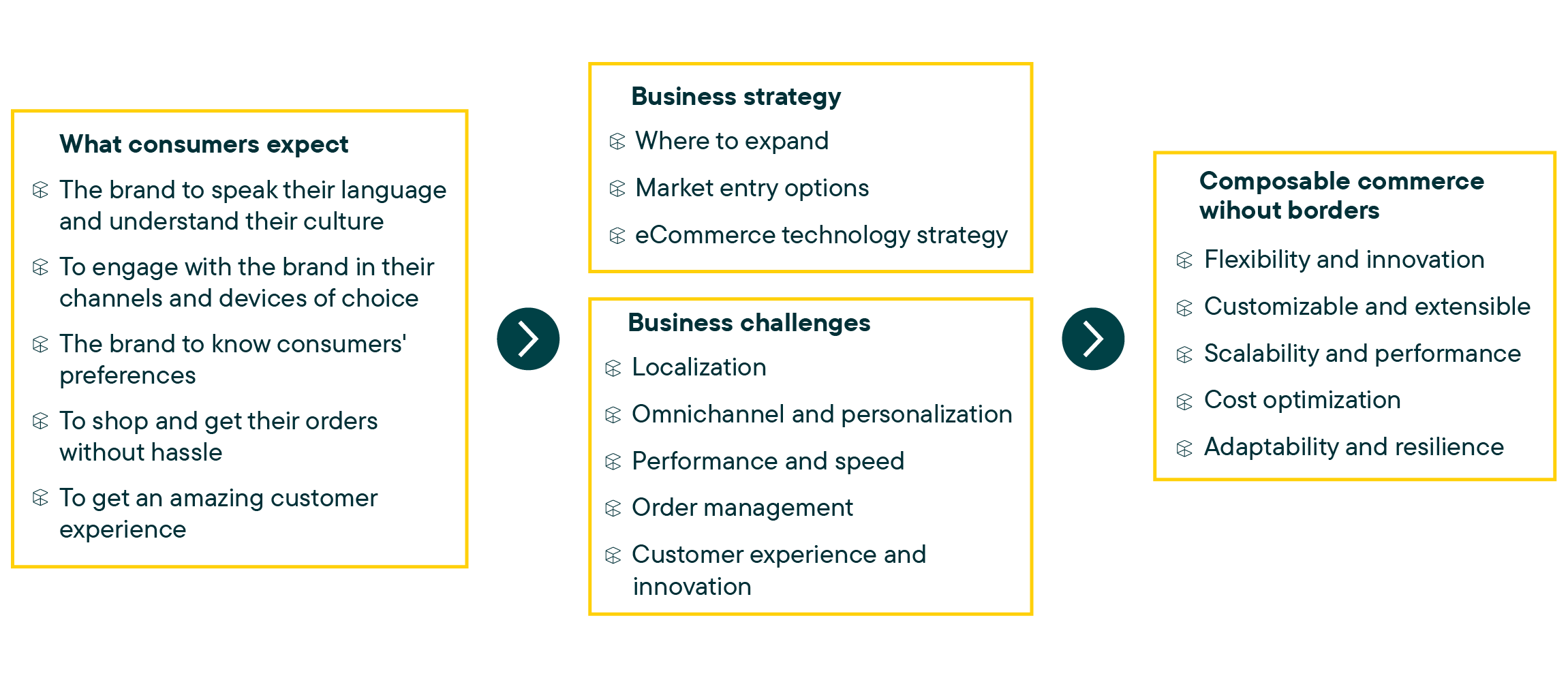Whether your business is expanding internationally for the first time or is already a global player, you’ll have immense opportunities and challenges arising from cross-border eCommerce. Here, learn how B2C businesses can expand internationally with composable commerce, so you can adapt successfully to local audiences and grow — no matter where you’re headed next.

The state of cross-border eCommerce
As the name suggests, cross-border eCommerce is about selling goods digitally beyond a company’s domestic market, usually to overcome saturation and create new opportunities.
While international trade isn’t new, cross-border digital commerce remains a key growth engine for businesses, even if it has taken a hit between 2020 to 2021 due to COVID-19, Brexit and international political tensions. Despite a potential recession in the years to come, digital-first commerce will remain a strategic path to build business resilience.
The share of eCommerce sales keeps climbing yearly and is expected to reach 24% of retail sales worldwide in 2026. The latest market projections forecast global eCommerce to jump from 5 trillion USD in 2022 to 7 trillion USD in 2025. The world’s top 250 retailers illustrated this shift during the COVID-19 lockdowns: The companies that have quickly moved from physical to digital accumulated double-digit sales growth. In contrast, the ones without a solid digital footprint lagged behind and struggled to survive.

The staggering increase in online shopping is also a critical driver in market expansions, with 72% of global businesses forging ahead in their international plans despite economic concerns and supply chain disruptions, investing heavily in digital as the way for sales growth. After all, nearly 20% of all eCommerce transactions will be cross-border, with the percentage of global consumers purchasing abroad reaching up to 45% in 2023. Other sources indicate that 70% of buyers in the US and 57% of worldwide consumers already shop internationally.
As the shift to online shopping becomes a permanent fixture of commerce, digital-native and brick-and-mortar businesses are exploring how to grow abroad as fast as possible.

Understanding consumer expectations
With 86% of buyers willing to pay a premium for a good experience, it’s clear that consumers reward brands for going the extra mile to craft experiences beyond a single transaction, injecting hyper-personalization and meaningful brand-to-consumer interactions.
So, if consumers expect great experiences, how does this requirement translate when they buy internationally? And how can brands carve out experiences matching consumer expectations to boost global sales? With a customer-centric approach to international expansion, businesses can increase engagement and sales no matter where they go next.

“I want the brand to speak my language and understand my culture”
Consumers have upped demands for cross-border transactions, with 40% expecting a localized checkout experience and 41% wishing to pay via their favorite payment methods. In addition, 47% of consumers say having a presence in their local market is a significant factor in choosing which brands they shop from.
“I want to engage with the brand in my channels and devices of choice”
No matter where they buy, today's consumers shop across multiple channels and devices. They expect to find and purchase products from various touchpoints, including brick-and-mortar storefronts, webshops, social media and apps using augmented/virtual reality (AR/VR). For example, in the social commerce space, consumers in China would prefer to use WeChat, while in Latin America, WhatsApp and Instagram are the go-to apps.
In addition to using the channels they’re already on, consumers expect to switch seamlessly from one medium to another. In addition, consumers increasingly use mobile devices to discover, compare and buy products, with mobile commerce expected to account for 43.4% of retail eCommerce sales in 2023.
“I want the brand to know what I like”
In a world where personalized offers and recommendations are relevant to 91% of consumers, and 63% of them will stop buying from brands that use poor personalization tactics, investing in personalized experiences is a no-brainer regardless if you’re operating locally or globally.
“I want to shop without hassle”
Unsurprisingly, consumers expect brands to provide engaging and fast storefronts. Features like search also play an immense role in the online shopping experience to shortcut product discovery in the vast sea of online options. Today, 43% of users go straight to the search bar on retail websites, and those who use search are two to three times more likely to convert.
“I want to get my order, no matter where the brand is based”
Consumers expect straightforward order fulfillment, product returns and shipping information regardless of where they buy. Cross-border shipping and delivery require top-notch logistics, order management and shipping options across numerous channels and countries.
“I want an amazing customer experience with new, exciting things”
Research shows that 95% of people think customer experience impacts a brand’s loyalty. Today, consumers look for more than a product; they choose brands that deliver comfort and positive emotions. Yet, 46% of consumers don’t distinguish one digital experience from another, leading to a low repeat purchase rate and poor fidelity. Brands with international ambitions need to rethink their customer experiences to stand out from the crowd. To achieve this, they need the agility to innovate and adapt to local markets at warp speed.
Get the cross-border eCommerce checklistShaping your cross-border eCommerce strategy
The first step is to decide where and how to expand — and the commerce technology to enable your cross-border expansion.
Even if you don’t yet serve international markets, interest in your goods and services may have crossed the border. Identify your leading territories and languages behind your highest traffic, rankings and conversions, and assess:
Market growth and eCommerce revenue forecast and demand.
Digital maturity and online penetration.
Localization: Market regulations and compliance, language, pricing strategy, etc.
International payments: Payment methods, currency conversions and volatility.
Shipping and distribution: Customs, tariffs, calculating total landing cost, reverse logistics for returns.
Geopolitical stability and economic developments.
With these insights, examine where to focus your efforts first and eCommerce market strategies that best fit your budget and goals.
International market entry strategies: Marketplaces vs. B2B2C vs. D2C
As each market has its own characteristics, consider the pros and cons of each eCommerce entry option: Marketplaces, B2B2C and direct-to-consumer (D2C).
With 47% of eCommerce transactions happening on marketplaces like Amazon and Alibaba, brands may consider it the easiest and cheapest option. Indeed, adding product catalogs to a marketplace presents near-zero investment or risk, which may be ideal for high-risk markets or as a starting point for an international expansion.
Brand-agnostic shoppers — those who know what they want but not who they want — tend to use online marketplaces, so they’re a great place to experiment before launching your D2C footprint. In the long run, however, marketplaces are essentially crowded platforms where brands have low visibility, compete on price and have no direct contact with customers.
B2B2C stands for business-to-business-to-consumer and, as the name implies, it’s a model in which a company sells its product or service in partnership with a B2C organization. This approach makes sense for companies wary of investing in a direct-to-consumer strategy due to a lack of budget or for highly regulated markets like China.
Direct-to-consumer (D2C) is the business model of selling products directly to consumers and bypassing third-party intermediaries, such as marketplaces or distributors. On the global stage, brands opt for D2C instead (or in addition to) adding products on marketplaces and/or opening physical stores to:
Control brand messaging and consumer engagement.
Create direct access to customers and their data for deeper personalization.
Gain higher margins and strengthen brand loyalty.
Companies can go D2C globally from a single website, which works well when targeting geographically close markets that share a common language, such as the US and Canada or Germany and Austria. A more sophisticated D2C alternative is to create localized eCommerce sites and touchpoints, which requires more effort and investment but is ideal for curating audiences and creating tailored customer experiences.
Ultimately, marketplaces are suitable for introducing your brand and creating early traction, especially in high-risk markets, and B2B2C is an option for regulated markets that are hard to enter. Creating a D2C approach, on the other hand, may require more investment, but it provides the foundation for growth in the long run for your strategic markets.
Technology strategy: All-in-one vs. composable commerce
Most companies still rely on all-in-one legacy platforms (also known as monoliths) built in the desktop-only eCommerce era. With consumers demanding deeper localization and personalization, companies using rigid commerce platforms face difficulties in expanding globally at scale. If you’re expanding to booming markets and need to efficiently manage new languages, currencies, logistics, taxes, etc., for multiple stores, ask yourself:
How does your eCommerce engine support your multi-country requirements, e.g., local compliance requirements for pricing and taxes?
How flexible is this platform for adding new features and touchpoints?
How scalable is it when confronted with traffic peaks from local seasonal events?
Consider how the tech stack should support your company’s cross-border growth when shaping your eCommerce strategy. If your company is stuck with outdated systems that can’t scale or localize experiences, it needs a technology overhaul with a flexible and agile approach, such as composable commerce.
As a modular development approach, composable commerce enables brands to leverage best-of-breed building blocks like search, cart, checkout and even new touchpoints, “composing” them in a cohesive customer experience. With composable commerce, you can expand these building blocks, contract or even swap them entirely for other solutions with maximum flexibility.
In a cross-border setting, a composable solution allows your company to administer local requirements without affecting global operations. You can add new languages, currencies, payment methods, channels and even locally-specific features without friction. Each component can be plugged (and unplugged) independently, so any changes you perform don’t affect performance or speed — nor do they interfere with your brand’s global standards.
In practice, you can balance central standardization and local individualism across design, shipping and payment methods, catalog structures, pricing and discounts, and more.
The result is clear: Your team can try different approaches, features and touchpoints to localize and personalize the customer experience. That way, you can better understand what resonates and what doesn’t, moving as fast as customer demands appear.
International eCommerce challenges and solutions
With a clearer understanding of your market entry strategy, it’s time to tackle the challenges of cross-border eCommerce, addressing the customer expectations of your local audiences. While it’s no easy feat to manage all the nuts and bolts of global trade, composable commerce enables you to tackle different countries, languages, currencies, local customizations and more.

Addressing local markets shouldn’t be an afterthought for your business. When adopting a D2C strategy, localizing your brand and products is the key to success. More than language translation, consumers expect brands to consider market and cultural aspects, including:
Language nuances, e.g., “sweater” in the US and “jumper” in the UK. A well-localized shop also directly impacts SEO performance.
Imagery with local models.
Locally relevant digital channels, e.g., WeChat in China and WhatsApp in Brazil.
Checkout for each locale’s pricing, currency and payment methods, plus the ability to work with dynamic pricing and conversion rates.
Seasonal campaigns, e.g., Cyber Week in the US and Diwali in India. For instance, Black Friday may happen at different times in different countries, as well as Valentine’s Day or Mother’s Day.
Industry-specific regulations and local requirements; fashion companies may have to adapt product information following local sizing.
Composable commerce enables global companies to with eCommerce localization based on consumers’ local preferences:
Visitors can choose the website’s language and location separately. This is particularly important for countries with multiple official languages, like Switzerland and Singapore.
Promote products and content for distinct audiences — from one commerce backend.
Manage localized content, images, products, payment methods, currencies and pricing as a single function in the commerce backend across distinct touchpoints.
By integrating with APIs, create and adapt commerce features suitable for specific local markets from third-party experts.
Danone, the food and beverage giant spanning 120 countries, has localized its D2C strategy for specific markets and products. During the COVID-19 pandemic, Danone faced shortages of baby nutrition products in Europe, which led to a localized checkout experience that limited the number of items purchased. This feature implemented across 12 countries ensured that the shortage seen in European stores wasn't replicated online.
Omnichannel may be a subset of localization, but there’s more than just plugging the channels customers want to engage in. In addition to managing multiple touchpoints, omnichannel commerce makes shoppable moments cohesive instead of disconnected channel hopping.
At the heart of omnichannel initiatives is a customer-centric approach to data. Brands should optimize data points across the buying journey in real-time, such as product information and availability, for seamless customer experiences. Customer data plays a crucial role in:
Data gathering and analytics provide a wealth of insights for brands, from top products consumers are attracted to and how they engage with touchpoints.
Activating crucial data enables brands to provide personalized recommendations and offers, engaging with consumers beyond a single transaction.
A successful omnichannel strategy for brands with a brick-and-mortar footprint is to connect “bricks and clicks”. Many consumers begin their journeys online and buy at the store after trying out the product. Conversely, others start in-store and prefer to purchase later online. Hybrid shopping is already the primary buying method for 27% of consumers and 36% of Gen Z.
Omnichannel fulfillment strategies like BOPIS also provide a fantastic way for brands to connect digital and in-store flows. For instance, out of 37 million grocery and retail user sessions in the US, France and the UK, in-store pickup customers spend on average 6% more than traditional shoppers. What to watch out for is that specific locales may be more mature than others, impacting where it makes sense to implement BOPIS and where it doesn’t.
Managing omnichannel appropriately is only possible with composable commerce. First, brands can add, combine and customize touchpoints to each market’s unique needs thanks to its modularity. Also, the flexible approach to data models enables brands to orchestrate data to:
Understand customers’ preferences, behaviors and purchase history across locations.
Provide relevant product recommendations and inspirational content.
Map the customer journey and identify pain points to optimize the customer experience.
Optimize inventory management, ensuring products are in the right place at the right time.
A great example of omnichannel commerce is Audi. To enable in-car commerce in 26 countries, Audi implemented a location-independent product information management (PIM) to maintain product data, such as prices, descriptions, functions and services, stored and managed via a central data maintenance system. Now, Audi customers can buy and activate new car functions via their myAudi app. Audi launched on-demand capabilities in Germany and rolled it out to 25 other European countries shortly after.
There are various aspects to achieving a high-performance and fast customer experience across touchpoints:
The ability to scale online capacity during traffic peaks — think Black Friday and Cyber Monday — is crucial for meeting demand without downtime or slowdowns.
Consistent information across touchpoints like product, pricing and inventory is crucial for a user-friendly experience. Customers should be able to find the product they’re looking for and the information they need, no matter what channel they’re using.
Mobile-first shopping is increasing globally; device responsiveness is a must-have.
Boosting website performance also means creating customer-centric storefronts that provide easy-to-access features, including Google-like search, streamlined checkout and modern payment solutions like mobile wallets.
With composable commerce, luxury watches platform CHRONEXT accelerated site speed performance by 300% across seven country storefronts Europe-wide and in Australia. The company plugged a brand-new CMS and product search, as well as improved mobile responsiveness and the storefront’s look and feel. With cloud-native capabilities behind the scenes, CHRONEXT can scale up online capacity during sales surges without downtime. Finally, the company also enhanced SEO rankings by 40% and increased conversions by 10%.
Shipping and delivery are significant challenges of cross-border eCommerce, such as customs delays, global supply chains and product returns. Managing accurate inventory data, as well as providing complete fulfillment information, are historically complex endeavors. While particular challenges will remain, composable commerce enables the optimization and automation of order management from start to finish by:
Aggregating data across every channel to optimize inventory, pricing and product assortments aligned with your business operations, so your international customers can order and get their goods without a hitch.
Organizing customer information, order history and status across countries.
Integrating logistics and supply chain as part of your order process.
Enable omnichannel fulfillment such as BOPIS, return management and more.
After a stunning global expansion, the commerce infrastructure of retailer Emma Sleep could no longer keep up with the company’s pace of growth. With the share of online sales comprising a whopping 80%, Emma transitioned to a best-of-breed composable stack connecting an order management system (OMS) via APIs. That way, Emma Sleep streamlined online and offline order management, providing a single view of global inventory and the ability to fulfill and return customers' orders more efficiently. Since migrating to composable commerce, the company is now present in 30 countries across Latin America, Europe, North America and APAC.
84% of companies who work to improve their customer experiences report an increase in revenue, regardless if they operate locally or globally. Investing in CX may seem a no-brainer, but making it a reality may be a complex endeavor — if you can’t innovate quickly.
And this is the catch when it comes to an international expansion: Creating customer experiences that resonate with local buyers may need an extra innovation push in terms of localization, personalization and omnichannel without conflicting with your global brand. This is where composable commerce shines; its modularity and flexibility make it easier to create and adapt your customer experiences by experimenting, trying things out and constantly shipping incremental innovation to wow your customers.
Australia’s leading lifestyle brand Koala has implemented composable commerce to push digital innovation like never before. The company chooses the ideal components for its CX via best-of-breed solutions, keeping control over how to glue them together for the best customer experience possible. Since then, Koala has expanded beyond Down Under to Japan and South Korea.
The benefits of composable commerce without borders
Companies exploring ways to expand internationally can fulfill their global ambitions with composable commerce, reaping a range of benefits:
Create a customer-centric commerce experience: Use best-of-breed business solutions to customize and localize customer experiences without limits.
Speed and agility: Say goodbye to months of planning to push an important feature to the market. With composable commerce's inherent flexibility and modularity, you can localize your approach on the fly, from new touchpoints to omnichannel fulfillment. That way, you can respond to market needs and localize experiences while remaining aligned with your global brand.
Scalability and performance: Increase the ability to handle online traffic peaks while maintaining high-speed performance to increase conversion rates and revenue.
Cost optimization: Eliminate costly workarounds and upgrades to customize functions and reduce the total cost of ownership (TCO) over time.
Adaptability and resilience: New customer demands and market changes are always on the horizon. Composable commerce allows your business to stay ahead of the curve and become more resilient, as you’re in charge of adapting your cross-border components according to your needs at any time.

Digital transformation projects are inherently complex — even more so when combined with cross-border eCommerce goals. While no single blueprint works for all companies, composable commerce is the foundation to help you in this journey.
How to get started with composable commerce for your international expansion? Download the cross-border eCommerce checklist to help you organize, manage and launch your growth plans globally.